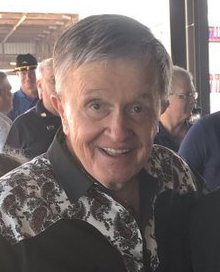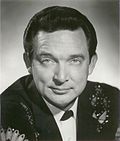Bill Anderson (singer)
James William Anderson III (born November 1, 1937), known as Whisperin’ Bill Anderson, is an American country music singer-songwriter and television personality. He has been a member of the weekly Grand Ole Opry radio program and stage performance in Nashville, Tennessee, beginning in 1961.[1]
Bill Anderson | |
|---|---|
 Bill Anderson in 2017 | |
| Background information | |
| Birth name | James William Anderson III |
| Also known as | Whisperin' Bill Anderson |
| Born | 1 November 1937
(aged 88) Columbia, South Carolina, U.S. |
| Genres | Nashville sound, country, bluegrass |
| Occupation(s) | Singer-songwriter, television personality |
| Instruments | Vocals, guitar |
| Years active | 1958–present |
| Labels | TNT Decca/MCA Southern Tracks Swanee Festival Curb |
| Associated acts | Jan Howard, Dolly Parton, Mary Lou Turner, Ray Price, Roger Miller, Connie Smith, Mel Tillis |
| Website | Bill Anderson Official Site |
He has released more than 40 studio albums and has reached No. 1 on the country charts seven times: "Mama Sang a Song" (1962), "Still" (1963), "I Get the Fever" (1966), "For Loving You" (with Jan Howard, 1967), "My Life (Throw It Away If I Want To)" (1969), "World of Make Believe" (1973), and "Sometimes" (with Mary Lou Turner, 1976).
In 2018, Anderson was added into the Songwriters Hall of Fame.[2]
In June 2019, The New York Times listed Anderson among hundreds of artists whose material was destroyed in the 2008 Universal Studios fire.[3]
Bill Anderson (singer) Media
Anderson briefly attended the University of Georgia in the late 1950s, where he studied journalism.
A promotional single for Anderson in Billboard, 1970
Anderson performing at the Grand Ole Opry, 2006
American country artist Ray Price was the first to record an Anderson composition.
Anderson and Arkansas Congressman Rick Crawford, 2017
References
- ↑ "Opry Member List PDF" (PDF). April 23, 2012. Archived from the original (PDF) on June 7, 2012. Retrieved June 29, 2012.
- ↑ "Songwriters Hall Of Fame Announces 2018 Inductees - Songwriters Hall of Fame". www.songhall.org. Archived from the original on 2018-05-08. Retrieved 2020-03-29.
- ↑ Rosen, Jody (June 25, 2019). "Here Are Hundreds More Artists Whose Tapes Were Destroyed in the UMG Fire". The New York Times. Retrieved June 28, 2019.






